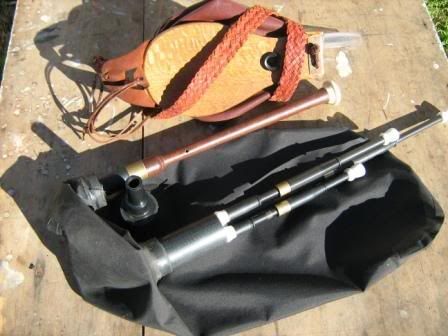Well, the information that you say is correct, but I´m not talking about the "asturian closed fingering". I´m talking about the "
Galician Closed fingering":
Open fingering in Galicia is a modern thing, and it´s adopted for play with clarinets (they use open fingering). In the process for get a chromatic scale, the closed fingering was not the best thing for get half-tones, so galician people adopted another fingering (the open fingering) more versatile for the chromatic labor.
Anyway, the closed fingering is the most ancient fingering in the world of bagpipes. Try to find an open fingering in the old world of bagpipes: it´s very difficult. In Galicia, the closed fingering was the antique form for play the bagpipes, like in Asturias, the difference is that Asturian bagpipes continue this tradition, and the Galician Bagpipes adopted the open fingering (most of them, but you can find a lot of old bagpipers that still use the closed fingering). Now you can find a closed-fingering revival in Galicia, because the good job of modern luthiers can get a closed fingering chanter with a chromatic guaranty.
The questions are: is the asturian closed fingering the same as galician closed fingering? Can we find only one galician closed fingering?
To the firts question, we can say that it´s not the same thing, but quite similar. The differences are in the FA# note fingering (talking in D major scale):
Asturian:
xxx xox o FA#
x
Galician:
xxx xoo o FA#
x
xxx xox x FA#
x
Also there are differences in the DO # note fingering:
Asturian:
xoo xxx o DO#
o
Galician:
ooo xxx o DO#
x
Also there are diferences in the DO note fingering:
Asturian:
ooo xxx o DO
x
Galician:
oxo xxx o DO
x
And of course, there are differences in the method for get half-tones, but this is not a traditional problem because ancient bagpipers usually plays only in major scales. Minor scale tunes are a very modern invent.
To the second question, we can use the same answer like the "traditional model of Galician bagpipe topic". You can find in Galicia three closed fingerings at least.
1.- Closed fingering of first type. Pontevedra zone (this fingering is collected in the book "Casto Sampedro")
xxx xxx x DO
x
xxx xxx o RE
x
xxx xxo o MI
x
xxx xox x FA#
x
xxx oxx x SOL
x
xxo xxx x LA
x
xoo xxx x SI
x
ooo xxx x DO#
x
xxx xxx o RE`
o
2.- Closed fingering: Melide zone (this fingering is very popular in the four-voiced bagpipes, or bagpipes with bass drone, tenor drone and double reed drone, where the tenor drone and the double-reed drone are fitted in a "V" form common stock.
xxx xxx x DO
x
xxx xxx o RE
x
xxx xxo o MI
x
xxx xoo o FA#
x
xxx oxx o SOL
x
xxo xxx o LA
x
xoo xxx o SI
x
ooo xxx o DO#
x
xxx xxx o RE`
o
3.- Closed fingering: Mixture (you can use the FA# note in closed or open version, acording to some ergonomic musical rules)
xxx xxx x DO
x
xxx xxx o RE
x
xxx xxo o MI
x
xxx xoo o FA# (Open Version)
x
xxx xox x FA # (Closed Version)
o
xxx oxx o SOL
x
xxo xxx o LA
x
xoo xxx o SI
x
ooo xxx o DO#
x
oxx xxx o RE`
x
ooo xxx o RE`
o
oox xxx o RE`
o
xxx xxx o RE`
o
In this post I have attached the last bagpipe picture of my collection. You can see my Gaita Tumbal in B with closed fingering chanter, made by my friend Diego Piñeiro from Santiago de Compostela (He also makes Xeremias from Mallorca, Galician Clarinets and other stuff): Boxwood, Brass and Cocobolo rings. Boxwood incrustations.Goat bag. Loud drone and loud double-reed drone. This bagpipe is like the old ones which are used in Pontevedra.
<a href="
http://s254.photobucket.com/albums/hh84 ... C01224.jpg" target="_blank"><img src="
http://i254.photobucket.com/albums/hh84 ... C01224.jpg" border="0" alt="Gaita de Diego 1"></a>
You can see here that chanter and little-drone (Ronquillo, Pieiro or Chillón) are using double-reeds. Ronquillo is a chanter who always plays the same note (the fifth):
<a href="
http://s254.photobucket.com/albums/hh84 ... C01225.jpg" target="_blank"><img src="
http://i254.photobucket.com/albums/hh84 ... C01225.jpg" border="0" alt="Gaita de Diego 2"></a>

























